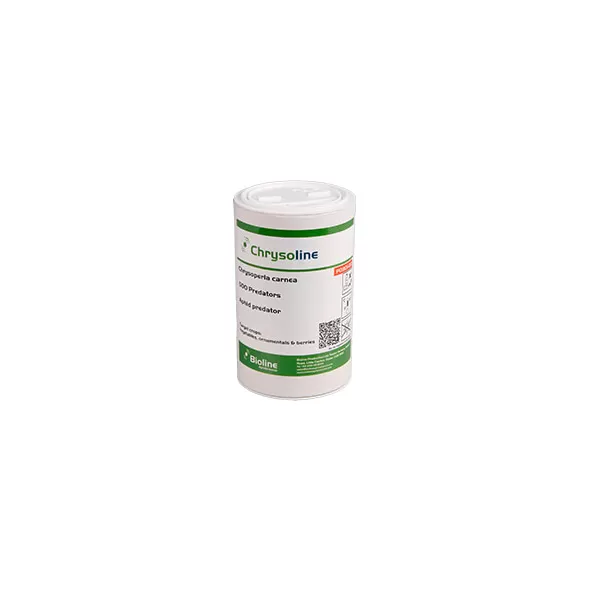Description
For effective and fast-acting control of aphids and other soft-bodied pests, Chrysoline offers a reliable biological alternative that is both efficient and easy to apply. Containing second instar larvae of Chrysoperla species, commonly known as Green Lacewings, Chrysoline delivers powerful curative treatment against active infestations. These larvae are voracious predators, capable of consuming hundreds of aphids in just a couple of weeks.
Unlike the adults, which feed only on nectar and pollen, the larvae are active hunters with powerful mandibles that target a wide range of pests. Their effectiveness, paired with ease of monitoring and application, makes Chrysoline a preferred solution for hotspot treatments in both greenhouse and open field crop systems.
How Chrysoline Works
Larval Predatory Power
The second instar larvae of Chrysoperla are the working agents in Chrysoline. These larvae are natural enemies of aphids, mealybugs, and other soft-bodied insects. They attack pests by piercing them with their mandibles and injecting digestive enzymes that liquefy internal tissues. The larvae then consume the internal fluids, quickly reducing pest populations.
-
One larva can consume up to 425 Aphis gossypii, 385 Myzus persicae, or 200+ Macrosiphum euphorbiae within 14 days at 21°C (69.8°F).
-
This high predation rate leads to rapid knock-down of pest colonies.
-
Because the larvae do not disperse until pupation, they remain localized at infestation sites, maximizing their curative impact.
Not Suitable for Preventive Use
Chrysoline should be used only as a curative treatment. Larvae require live prey to survive and develop, making them unsuitable for preventive application. Without prey, the larvae may cannibalize each other, reducing effectiveness.
Application Recommendations
Targeted Hotspot Release
Due to their fast action and high prey consumption rate, Chrysoline larvae are perfect for localized infestation zones or hotspot treatment. Apply directly onto aphid colonies for immediate effect.
-
Open the container in a shaded area within the greenhouse or field.
-
Sprinkle the larvae and carrier material directly onto plants with visible aphid activity.
-
Ensure the carrier material adheres to foliage initially; if it drops to the ground, many larvae may be lost.
Because the adults disperse after emergence, multiple or follow-up applications may be necessary to maintain long-term control in large or open environments.
Pest Targets
Chrysoline is highly effective against:
-
Aphids (all major species)
-
Mealybugs (early-stage control)
Its wide host range makes it ideal for growers dealing with multi-pest infestations, especially in mixed or ornamental crops where exact species identification may be difficult.
Life Cycle and Behavior
-
Larvae remain at feeding sites and are easy to observe.
-
Adults emerge from pupae and disperse in search of nectar and pollen.
-
Female lacewings lay individual eggs on long, slender stalks on the undersides of leaves.
-
Upon hatching, the larvae immediately descend to the leaf surface and begin searching for prey.
Because they remain where they hatch and do not require dispersal time, Chrysoline provides instant results when applied to infested crops.
Packaging and Delivery Formats
Chrysoline is available in various packaging sizes to accommodate different operational scales:
-
500mL cardboard tube – 500 second instar larvae
-
1L cardboard tube – 1,000 second instar larvae
-
5L bag – 2,500 second instar larvae
-
Four 5L bags (case) – 10,000 larvae
All units contain larvae mixed with a carefully formulated carrier medium that aids in application and survival.
Handling and Storage Guidelines
To ensure optimal performance and viability of the larvae:
-
Store and transport at 6–10°C (43–50°F) in complete darkness.
-
Do not expose to direct sunlight at any time.
-
Store containers horizontally to maintain even distribution.
-
Use within 18 hours of delivery.
-
Keep containers in a cool, shaded area before use.
When applying, handle gently and distribute the carrier medium evenly over aphid colonies for best effect.
Final Words
Chrysoline offers a precise, fast-acting biological control method for managing aphids and mealybugs. The predatory larvae of Chrysoperla are aggressive feeders and effective even at moderate temperatures. Perfect for curative applications, Chrysoline enables growers to reduce chemical usage, control hotspots efficiently, and maintain a clean, healthy crop. If you're facing visible infestations and need a natural, rapid-response solution, Chrysoline delivers powerful biological action exactly where it’s needed.
Reviews
No reviews found




